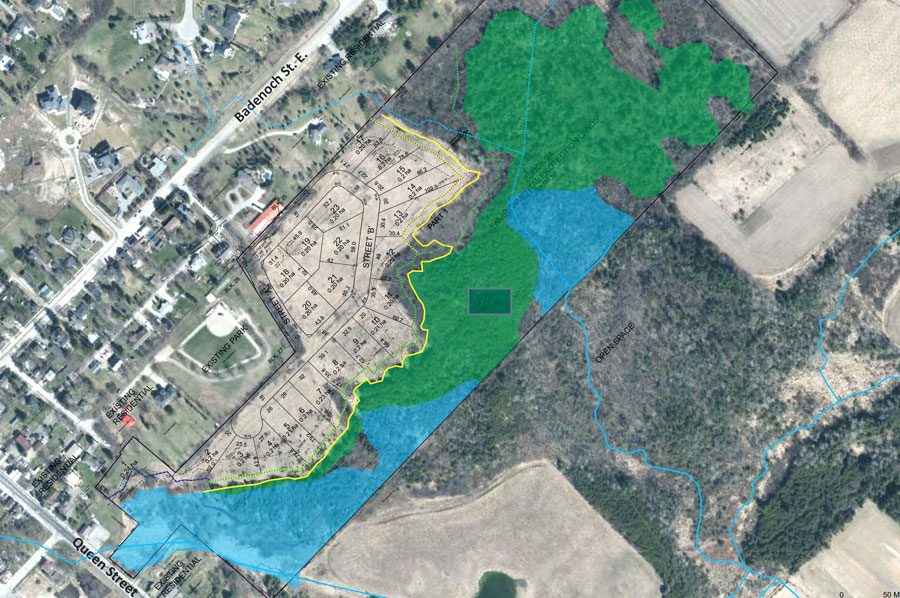MORRISTON – Traffic was the main concern raised at a public meeting on March 5 about a residential development proposal in Morriston.
Weston Consulting planner Kayley Robbins presented the plan for a 23-hectare piece of property at 11 Main St., which is near the intersection of Highway 6 and Badenoch Street, the main intersection in the hamlet.
The plan is to build 21 one- and two-storey single family homes ranging in size from 2,500 to 3,000 square feet, each on a half-acre lot.
The land is currently vacant and a large part of it is zoned greenland or core greenland because it contains wetlands and woodlands.
The remainder is zoned future development with a portion zoned urban residential.
The proponent, WDD Main Street Inc., is seeking to change the zoning to urban residential, which would allow the homes and, possibly, home-based businesses.
The proponent would build a new interior road to township standards that would link to the existing Back Street and Ochs Street.
Each of the homes would have its own well and septic system. There would be a stormwater management pond to handle drainage on the site.
The proposed subdivision would be south of the old Morriston Ball Diamond.
The proponent has also submitted a draft plan of subdivision application with Wellington County.
The traffic impact study, by GHD Ltd., proved the most contentious issue of the evening.
Multiple residents raised concerns about the intersections where Main and Ochs streets meet Badenoch Street, which is also Wellington Road 36.
Badenoch Street has a hill that makes it dangerous to make a left turn from Ochs Street onto Badenoch, many residents stated.
It’s also a narrow road that can barely accommodate two passing cars, they said.
The planner has suggested Ochs Street would be the preferred access point for the new subdivision.
“It won’t work,” one man stated. “You can’t make a left turn. You can’t do it in winter.”
The traffic study suggested relocating a retaining wall at the corner of Ochs and Badenoch to improve site lines, but many in the room didn’t think that would address the issue of being at the crest of a hill.
They thought most of the new residents would turn down Back Street and exit from Main Street onto Badenoch Street.
Neither Back nor Main could handle that kind of traffic, they said.
Others suggested Main Street should be extended in the other direction to Highway 6 and that should be the main access to the subdivision.
But Robbins said the Ministry of Transportation, which controls Highway 6, won’t permit access there because it’s too close to the lights at Badenoch Street.
And an extension of Main Street would go through protected wetlands, which is both impractical and not allowed.
“The MTO could change their minds,” another man suggested, encouraging the proponent to give the MTO another try.
“The sightlines on Ochs Street are dangerous.”
According to the traffic study, the proposed development would generate 20 new two-way trips during peak morning weekday hours and 25 new two-way trips during peak evening hours.
“The overall impact of the development-generated traffic was found to be negligible to the operation of the study area intersections and traffic flow along Highway 6 and Badenoch Street,” the study states.
Residents at the meeting didn’t buy that reasoning either.
“I think there will be more cars than you think,” said another man, noting the proposed homes are large and could house more than one family, leading to more cars in the neighbourhood.
A woman noted Highway 6 is a regular detour route when there are accidents on Highway 401 and detour traffic should also be considered as it is a regular – sometimes daily – occurrence, she said.
Councillor John Sepulis wondered if signal lights could be installed at Ochs and Badenoch streets. Robbins said she’d take that suggestion back to her team.
Councillor Sara Bailey wanted to know how to ask the traffic consultant about its study and whether more information could be collected before making a decision.
Councillor Jessica Goyda asked who would own the protected greenland parcel of land once the homes were inhabited.
That’s an ongoing discussion, she was told.
Councillor Russel Hurst wanted to be sure emergency vehicles could access the subdivision.
Mayor James Seeley, who had earlier declared a conflict of interest because he lives in the area, did not attend.
There will be another public meeting on the proposal.
Sepulis suggested the traffic consultant should attend since traffic was the biggest concern raised.
“This meeting has been very helpful,” Robbins noted as the meeting came to a close.



